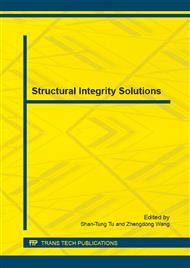p.139
p.145
p.153
p.160
p.166
p.172
p.178
p.186
p.192
Research on Stress Intensity of Variable Cross-Section H-Type Structure in Heat Exchanger with Longitudinal Flow of Shell Side
Abstract:
The variable cross-section H-type structure, which is used in the new type of heat exchanger with longitudinal flow of shell side, could reduce the scour action of imports fluid on the tube bundle and prevent vibration of the tube bundle. It could also improve the state of the shell side fluid flow, reducing the flow dead zone, allowing for a more efficient use of the heat transfer area and improving the energy efficiency. The new structure will make the temperature and stress distribution in the heat distribution more complex, so it is necessary to analyze the stress intensity of the variable cross-section H-type structure. A three-dimensional finite element model of the variable cross-section H-type structure is established in this paper, and the surface temperature of the various parts of the heat exchanger are determined through temperature analysis. Using ANSYS Workbench software, thermal-stress analysis of the H -type structure with different structural parameters is tested, and the temperature and stress field are obtained. The results show that a Ring plate of H-type structure has a larger temperature gradient along the thickness direction. The maximum stress of the heat exchanger is 203.13 MPa, which occurred on the connections of the ring plate and jacket in the lower temperature side. The ring plate thickness of the H-type structure has a significant influence on its maximum stress. Therefore, a reasonable selection of ring plate thickness is important for the safety of the heat exchanger.
Info:
Periodical:
Pages:
166-171
Citation:
Online since:
April 2015
Authors:
Price:
Сopyright:
© 2015 Trans Tech Publications Ltd. All Rights Reserved
Share:
Citation:


